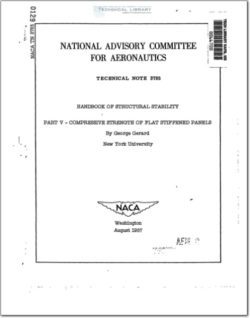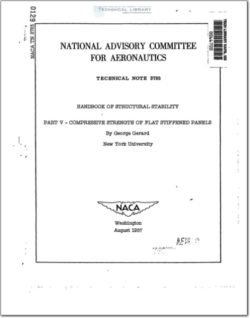NACA-TN-3785

- Version
- 1594 Downloads
- 3.30 MB File Size
- 1 File Count
- December 4, 2015 Create Date
- December 4, 2015 Last Updated
National Advisory Committee for Aeronautics, Technical Notes - Handbook of Structural Stability Part V - Compressive Strength of Flat Stiffened Panels

A generalized crippling analysis for short panels with formed or
extruded stiffeners is presented. The analysis applies to monolithic
panels. Criteria are given for riveted panels which indicate if the
panels can be considered to behave in a monolithic manner. Riveted
panels that are subject to interrivet buckling and wrinkling or forced
crippling do not behave in this manner. Methods are presented for esti-
mating the strength of such panels.
Intermediate-length and long stiffened panels are subject to other
failure modes. Methods are given for estimating the column strength of
panels. Various forms of column curves and direct-reading charts are
considered. Theory and test data on optimum stiffened panels are pre-
sented for use in preliminary design studies.
In box types of construction, the rib and spar structures influence
the compressive strength of the stiffened panel. Ellie various factors
which can be of importance are considered.
This part of the Handbook of Structural Stability is concerned with
the compressive strength of flat stiffened panels both in the form of
individual panels and as components of box structures under bending.
Considerations of the canpressive strength of stiffened panels are
governed to a. large extent by the crippling or short—panel strength.
This quantity is commonly determined experimentally on panels with an
effective slenderness ratio in the neighborhood of 20. In this region,
variations in length have a negligible effect upon the crippling strength.
In Part IV of this Handbook (ref. 1), a generalized crippling analy-
sis was presented for individual formed and extruded elanents. This
method of analysis is extended to panels with formed stiffeners in the
section "Crippling Strength of Panels With Formed Stiffeners" and to
panels with extruded stiffeners in the section "Crippling Strength of
Panels With Extruded Stiffeners" herein. At the end of the last-named
section, the pertinent results of the generalized crippling analysis are
stmmarized.
| File | Action |
|---|---|
| naca-tn-3785.pdf | Download |

Comment On This Post